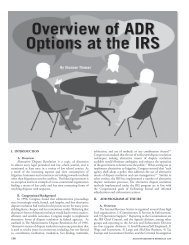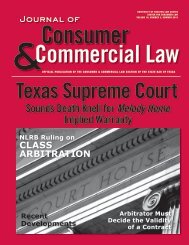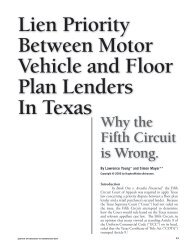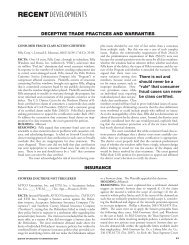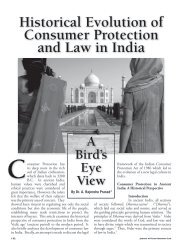Teaching Consumer Credit Law in an Evolving Australian Economy
Teaching Consumer Credit Law in an Evolving Australian Economy
Teaching Consumer Credit Law in an Evolving Australian Economy
Create successful ePaper yourself
Turn your PDF publications into a flip-book with our unique Google optimized e-Paper software.
RECENT DEVELOPMENTS<br />
rules. Texas courts, however, have looked to federal law <strong>in</strong><br />
apply<strong>in</strong>g the lodestar method of calculat<strong>in</strong>g attorney’s fees,<br />
<strong>in</strong>clud<strong>in</strong>g the TCHRA, which provides for <strong>an</strong> award of attorney’s<br />
fees to the prevail<strong>in</strong>g party as part of the costs.<br />
The lodestar method <strong>in</strong>volves two steps. First, the court<br />
must determ<strong>in</strong>e the reasonable hours spent by counsel <strong>in</strong> the<br />
case <strong>an</strong>d a reasonable hourly rate for such work. Second, the<br />
court multiplies the number of such hours by the applicable rate<br />
to adjust the base lodestar up or down. The method aims to<br />
provide a relatively objective measure of attorney’s fees. A trial<br />
court should obta<strong>in</strong> sufficient <strong>in</strong>formation to make a me<strong>an</strong><strong>in</strong>gful<br />
evaluation of the application for attorney’s fees. Charges for<br />
duplicative, excessive, or <strong>in</strong>adequately documented work should<br />
be excluded.<br />
The party apply<strong>in</strong>g for <strong>an</strong> award of attorney’s fees under<br />
the lodestar method bears the burden to prove the hours<br />
expended were reasonable by evidenc<strong>in</strong>g, at a m<strong>in</strong>imum, (1)<br />
the nature of the work, (2) who performed the services <strong>an</strong>d<br />
their rate, (3) approximately when the services were performed,<br />
<strong>an</strong>d (4) the number of hours worked. A simple way to meet<br />
these requirements is to record or document the hours.<br />
Documentation should occur reasonably close to the time<br />
when the work is performed. In <strong>in</strong>st<strong>an</strong>ces where there are<br />
multiple attorneys work<strong>in</strong>g on the same case, the evidence for<br />
fee application needs to have stated which attorney performed<br />
what tasks at what hourly rate.<br />
Olivas’ attorneys did not <strong>in</strong>dicate how the 890 hours they<br />
spent <strong>in</strong> the aggregate were devoted to <strong>an</strong>y particular task or category<br />
of tasks. The attorneys based their time estimate on generalities<br />
such as the amount of discovery, the number of plead<strong>in</strong>gs<br />
filed, the number of witness questioned, <strong>an</strong>d the length of the<br />
trial. The court held that the evidence failed to show how m<strong>an</strong>y<br />
hours each of the tasks required <strong>an</strong>d whether that time was reasonable.<br />
Overall, the evidence<br />
was <strong>in</strong>sufficient for a lodestar<br />
calculation, <strong>an</strong>d the court reversed<br />
the fee calculation established<br />
by the trial court.<br />
In the second step of<br />
lodestar method, a trial court<br />
may use a multiplier to <strong>in</strong>crease<br />
or decrease the lodestar<br />
The evidence failed<br />
to show how m<strong>an</strong>y<br />
hours each of the<br />
tasks required <strong>an</strong>d<br />
whether that time<br />
was reasonable.<br />
to approximate a reasonable fee if relev<strong>an</strong>t factors <strong>in</strong>dicate <strong>an</strong> adjustment<br />
is necessary to reach a reasonable fee <strong>in</strong> the case. A<br />
list of non-exclusive of factors <strong>in</strong>cludes: (1) the time <strong>an</strong>d labor<br />
required, the novelty <strong>an</strong>d difficulty of the questions <strong>in</strong>volved, <strong>an</strong>d<br />
the skill requisite to perform the legal service properly; (2) the<br />
likelihood, if apparent to the client, that the accept<strong>an</strong>ce of the<br />
particular employment will preclude other employment by the<br />
lawyer; (3) the fee customarily charged <strong>in</strong> the locality for similar<br />
legal services; (4) the amount <strong>in</strong>volved <strong>an</strong>d the results obta<strong>in</strong>ed;<br />
(5) the time limitations imposed by the client or by the circumst<strong>an</strong>ces;<br />
(6) the nature <strong>an</strong>d length of the professional relationship<br />
with the client; (7) the experience, reputation, <strong>an</strong>d ability of the<br />
lawyer or lawyers perform<strong>in</strong>g the services; <strong>an</strong>d (8) whether the fee<br />
is fixed or cont<strong>in</strong>gent on results obta<strong>in</strong>ed or uncerta<strong>in</strong>ty of collection<br />
before the legal services have been rendered.<br />
The court first needs a base fee to determ<strong>in</strong>e whether or<br />
not a multiplier would be necessary. The lodestar presumptively<br />
produces a reasonable fee, but exceptional circumst<strong>an</strong>ces, such as<br />
<strong>an</strong>y of the factors listed above, may justify <strong>an</strong> <strong>in</strong>crease or decrease<br />
<strong>in</strong> the base fee. Because the court rejected the base fee established<br />
by the trial court, it decl<strong>in</strong>ed to determ<strong>in</strong>e if a multiplier was<br />
necessary.<br />
Journal of <strong>Consumer</strong> & Commercial <strong>Law</strong> 55



